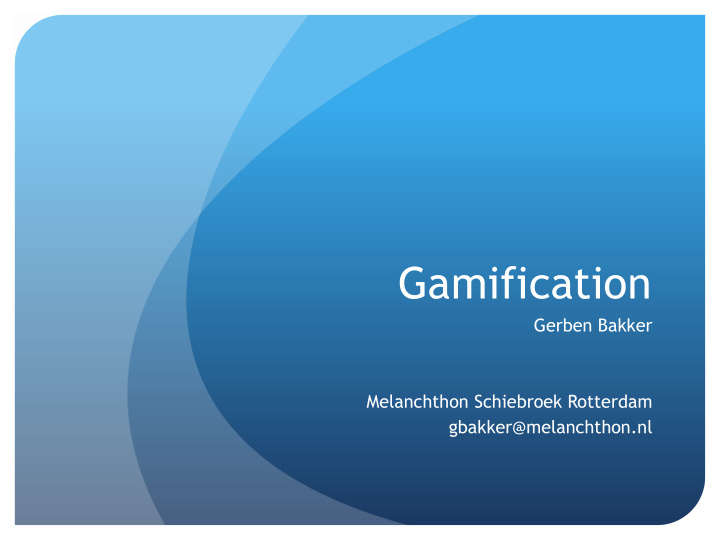



Gamification Gerben Bakker Melanchthon Schiebroek Rotterdam gbakker@melanchthon.nl
Subjects to be covered What is gamification? The promises The controversies Scientific basis
Definition Gamification is the use of game design elements in non-game contexts. (Deterding et al, 2011)
Game design elements: concrete to abstract Badges, points, leaderboards, levels Time constraint, limited resources, turns Narrative, enduring play, clear goals, variety of game styles Challenge, fantasy, curiosity Playcentric design, playtesting, value concious game design (Deterding et al, 2011)
Non-game contexts
Vodaphone firestarters: Ahead of the game https://www.youtube.com/watch?v=y55vxYaJB9U&feature=youtu.be
Vodaphone firestarters: Ahead of the game https://www.youtube.com/watch?v=y55vxYaJB9U&feature=youtu.be
Education
Duolingo www.duolingo.com
Some of the promises Motivation and engagement Direct feedback enhancing perceived competence Insight in the structure of knowledge (skill trees) Immersion and meaning through narrative Monitoring/personalised learning
Controversies Some of the main objections
Degradation?
Manipulation?
Applying gamification is hard and complex! Examples: Not just a few game elements slapped together Complex interaction between elements Small changes might have big consequences Game designer AND educator at the same time Risks of rewards: Overjustification effect
Scientific basis
Scientific basis Strong theoretical support for gamification from motivation- and learning theory, very little empirical research to back up said support. Many publications on serious games, which is NOT gamification.
Serious game vs Gamification Gamification is gameful design, but not a full-fledged (serious) game! Source of picture: https://community.lithium.com/t5/Science-of-Social-blog/What-is- Gamification-Really/ba-p/30447
(De sousa Borges, 2014)
(Caponetto et al, 2014)
Resources Articles: Deterding, S., Dixon, D., Khaled, R., & Nacke, L. (2011, September). From game design elements to gamefulness: defining gamification. In Proceedings of the 15th International Academic MindTrek Conference: Envisioning Future Media Environments (pp. 9-15). ACM. De Sousa Borges, S. Macedo Reis, H., Durelli, V.H.S., Isotani, S. (2014). A systematic mapping on gamification applied to education. In SAC '14 Proceedings of the 29th Annual ACM Symposium on Applied Computing (pp. 216-222). ACM Caponetto, Ilaria, Jeffrey Earp, and Michela Ott. "Gamification and Education: A Literature Review." ECGBL2014-8th European Conference on Games Based Learning: ECGBL2014 . Academic Conferences and Publishing International, 2014. Stott, A., & Neustaedter, C. (2013). Analysis of gamification in education. Surrey, BC, Canada .
Resources Books: Kapp, K. M. (2012). The gamification of learning and instruction: game-based methods and strategies for training and education . John Wiley & Sons. Sheldon, L. (2011). The multiplayer classroom: Designing coursework as a game . Cengage Learning. Websites: https://www.learnboost.com/blog/3-reasons-not-to-gamify-education/ http://www.mrdaley.com/wordpress/2011/07/27/education-levels-up-a-newbs-guide-to-gamifying-your- classroom/ https://www.youtube.com/watch?v=7ZGCPap7GkY (Meaningful Play: Getting Gamification Right)
Questions
Corporate: External Sales Marketing
Corporate: Internal Human resources Productivity Crowdsourcing
Overjustification-effect
Education
(Caponetto et al, 2014)
Recommend
More recommend